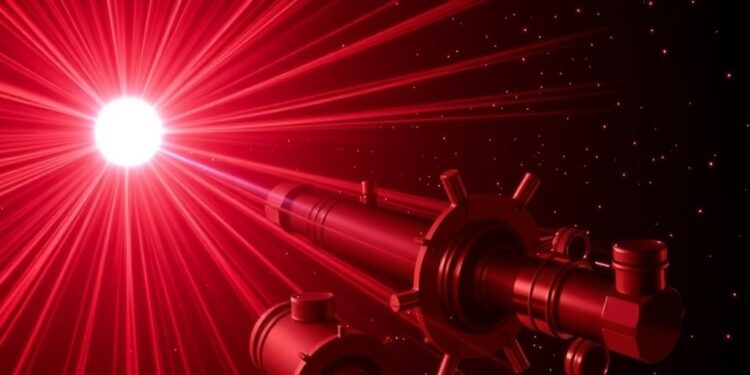Researchers engaged in the KATRIN (Karlsruhe Tritium Neutrino) experiment have unveiled groundbreaking findings that significantly refine our understanding of neutrino mass. For a long time, neutrinos have remained one of the universe’s most enigmatic particles, with their minimal mass escaping precise measurement. Recent research has established an upper limit of 0.45 electron volts (eV) for the mass of the electron neutrino, fundamentally enhancing the constraints imposed on this elusive particle and challenging the foundational principles of the Standard Model of particle physics.
Neutrinos are unique in the pantheon of elementary particles; they possess no electric charge and are, by far, the most ubiquitous particles in the cosmos. Existing in three distinct varieties known as “flavors” – electron neutrinos, muon neutrinos, and tau neutrinos – they engage in a phenomenon known as oscillation. This process allows one type of neutrino to transmute into another during its journey through space. Such oscillations provide compelling evidence that contradicts the Standard Model’s long-held assumption that neutrinos are massless. The exact mass of neutrinos, however, remains one of the most perplexing questions in the realm of particle physics.
Led by Max Aker and the KATRIN Collaboration, this study emerges from the first five measurement campaigns of the KATRIN experiment, aimed specifically at measuring the mass of the electron neutrino with unparalleled precision. The process employed by KATRIN involves analyzing the beta decay of tritium. During this process, a neutron transitions into a proton while emitting both an electron and an electron antineutrino, the latter being the neutrino’s antiparticle. Analyzing the energy distributions of the emitted electron and the accompanying antineutrino enables scientists to infer the mass of the neutrino itself.
Between 2019 and 2021, the KATRIN Collaboration engaged in extensive measurements, dedicating 259 days to gather data on roughly 36 million emitted electrons. This substantial dataset is six times larger than what previous studies had amassed, greatly enhancing the reliability and precision of the resulting calculations. These newly published results establish the most stringent upper limit ever determined for the effective mass of the electron neutrino, now placed at less than 0.45 eV, with a confidence level of 90%. This achievement marks a pivotal refinement in the ongoing quest to unravel the mysteries surrounding neutrinos.
The implications of this research are profound, as it not only tightens existing constraints on neutrino mass but also nudges the boundaries of physics beyond the Standard Model. The KATRIN experiment continues to be a beacon of hope for future discoveries, with further data collection scheduled to conclude in 2025 after achieving 1,000 days of comprehensive data-gathering efforts. Loredana Gastaldo, in a related Perspective piece, highlights that an exhaustive analysis of this grand dataset could pave the way for estimating the effective electron neutrino mass closer to a projected value of 0.3 eV, again with a 90% confidence level.
The enduring mystery surrounding neutrinos is not merely academic; it has significant implications for our understanding of the universe. Neutrinos interact weakly with matter, which renders them difficult to detect and study. Their potential role in various astrophysical processes and their connection to the evolution of the universe makes them pivotal to our scientific inquiries. The mass of neutrinos is integral to theories of cosmology and the evolution of the cosmos, and refining this parameter is paramount for unlocking new realms of theoretical physics.
These recent results from the KATRIN experiment not only bolster our understanding of particle physics but also stimulate discussions regarding potential new physics beyond the Standard Model. As researchers continue to probe deeper into the complex nature of neutrinos, the findings may herald a new era in particle physics, characterized by fresh perspectives and innovative theoretical frameworks. Scientists are keenly observing developments from KATRIN, as each refinement in measurements could significantly alter our understanding of the fundamental components of the universe.
In summary, the KATRIN experiment stands at the forefront of a thrilling research endeavor that seeks to decode one of nature’s secrets: the mass of the neutrino. With its latest findings, KATRIN not only solidifies its invaluable contributions to the scientific community but also inspires hope for future breakthroughs that could lead to a more comprehensive understanding of the fundamental laws governing the universe.
This ongoing research will undoubtedly attract significant attention from both the scientific community and the general public, as the quest to comprehend neutrinos continues. Scientists eagerly await the results that will emerge from the remaining measurement campaigns, potentially reshaping our conceptualizations of particle interactions and the very fabric of reality itself.
The narrative unfolding around the KATRIN experiment marks a compelling chapter in the saga of neutrino research—a chapter that promises to bridge gaps in our knowledge and illuminate pathways to new scientific revelations.
Subject of Research: Neutrino Mass Measurement
Article Title: Direct neutrino-mass measurement based on 259 days of KATRIN data
News Publication Date: 11-Apr-2025
Web References: Science Journal
References: N/A
Image Credits: N/A
Keywords
Neutrino, KATRIN, Mass Measurement, Particle Physics, Standard Model, Tritium Decay, Electron Neutrino, Oscillation, Cosmology, Fundamental Particles, Data Analysis, Scientific Research.




